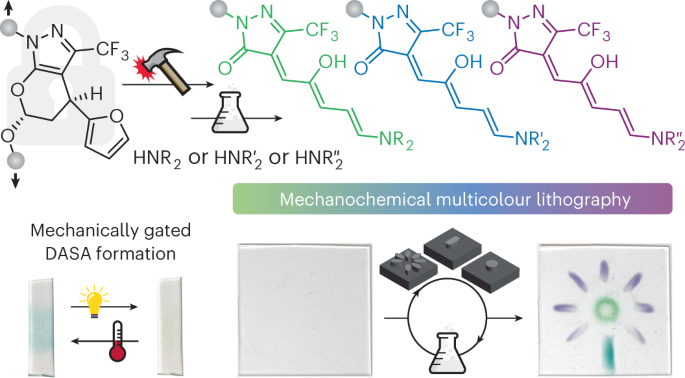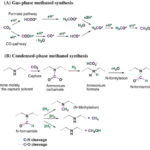2023-01-23 カリフォルニア工科大学(Caltech)
◆ロブ・グループの最新の研究を理解するためには、まず、これまでに開発された色変わりするプラスチックの仕組みを知ることが役立つ。ストレスに反応して色が変わるプラスチックを作るには、メカノフォアと呼ばれる一種の分子が必要である。このメカノフォアには多くの種類があり、色が変わるものは一部ですが、基本的な仕組みはほとんど同じです。分子は2つの状態で存在し、外力を受けると化学反応を起こし、1つの状態から別の状態に変換します。ロブの研究チームが扱うメカノフォアは、一方が無色で、もう一方が有色である。メカノフォアをプラスチックに組み込むと、プラスチックに加えられた力を感知して色が変わり、その応力の位置が可視化される。
◆この研究チームの最新の研究で開発したメカノフォアは、力によって直接色が変わるのではなく、ドナー・アクセプター・ステンハウス付加体(DASA)と呼ばれる無数の鮮やかな色の色素に変換できる中間化合物を生成する。無色のメカノフォア分子もプラスチックに組み込まれるが、分子構造の変化により、二次的な化学反応を起こすことができる。このプロセスをメカノケミカルゲーティングと呼ぶ。化学的に受容された状態になった後、化学浴によって別の分子片を構造上に付加する「現像」が行われる。この分子片が、大きな分子を鮮やかに着色する。研究者は、貼り付ける分子片を変えることで、色を任意の色に調整することができる。
◆Robbの研究室の研究者達は、このプラットフォームのデモンストレーションとして、新しいメカノフォア分子を含む伸縮性ポリマーのシートを用意し、特定の領域に応力を与えるパターンを刻印しました。次に、このシートを薬液に浸して、パターンを紫色に変化させた。このプラスチックに、もう1度新しいパターンを押し、別の化学薬品で現像すると、新しく押した部分が青く変色した。そして最後に、3回目のスタンプを押し、最後に押した部分を緑色にする薬品で現像しました。この3つのスタンプの組み合わせで、プラスチックの中に多色の花の絵が描かれるのです。また、DASAは光によっても色が変わるので、懐中電灯で照らして消すこともできる。
<関連情報>
- https://www.caltech.edu/about/news/a-rainbow-of-force-activated-pigments
- https://www.nature.com/articles/s41557-022-01126-5
メカニカルゲートによるドナー・アクセプター・ステンハウス付加体の形成とメカノケミカル・マルチカラーソフトリソグラフィーの実現 Mechanically gated formation of donor–acceptor Stenhouse adducts enabling mechanochemical multicolour soft lithography
Anna C. Overholts,Wendy Granados Razo & Maxwell J. Robb
Nature Chemistry Published:23 January 2023
DOI:https://doi.org/10.1038/s41557-022-01126-5

Abstract
Stress-sensitive molecules called mechanophores undergo productive chemical transformations in response to mechanical force. A variety of mechanochromic mechanophores, which change colour in response to stress, have been developed, but modulating the properties of the dyes generally requires the independent preparation of discrete derivatives. Here we introduce a mechanophore platform enabling mechanically gated multicolour chromogenic reactivity. The mechanophore is based on an activated furan precursor to donor–acceptor Stenhouse adducts (DASAs) masked as a hetero-Diels–Alder adduct. Mechanochemical activation of the mechanophore unveils the DASA precursor, and subsequent reaction with a secondary amine generates an intensely coloured DASA. Critically, the properties of the DASA are controlled by the amine, and thus a single mechanophore can be differentiated post-activation to produce a wide range of functionally diverse DASAs. We highlight this system by establishing the concept of mechanochemical multicolour soft lithography whereby a complex multicolour composite image is printed into a mechanochemically active elastomer through an iterative process of localized compression followed by reaction with different amines.




